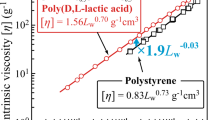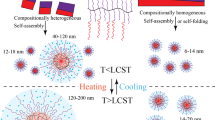Abstract
This article reviews previous studies on micellar structures formed by hydrophobically modified polysaccharides in aqueous solutions by static and dynamic light scattering, small angle X-ray and neutron scattering, and fluorescence from pyrene solubilized in polymer solution. The experimental results are consistently explained by the full or loose flower necklace model for pullulan bearing octenyl groups and amylose bearing dodecyl groups and by the randomly branched polymer model, which is often called a “nanogel”, for pullulan bearing cholesteryl groups. We discuss the micellar structures of hydrophobically modified polysaccharides as well as of an amphiphilic alternating vinyl polymer bearing dodecyl groups in regard to the degree of substitution as well as the chemical structures of the hydrophobic moiety and backbone chain.
This is a preview of subscription content, access via your institution
Access options
Subscribe to this journal
Receive 12 print issues and online access
$259.00 per year
only $21.58 per issue
Buy this article
- Purchase on Springer Link
- Instant access to full article PDF
Prices may be subject to local taxes which are calculated during checkout






Similar content being viewed by others

References
Janes KA, Calvo P, Alonso MJ. Polysaccharide colloidal particles as delivery systems for macromolecules. Adv Drug Deliv Rev. 2001;47:83–97.
Prabaharan M, Mano JF. Chitosan-based particles as controlled drug delivery systems. Drug Deliv. 2005;12:41–57.
Liu Z, Jiao Y, Wang Y, Zhou C, Zhang Z. Polysaccharides-based nanoparticles as drug delivery systems. Adv Drug Deliv Rev. 2008;60:1650–62.
Prajapati VD, Jani GK, Khanda SM. Pullulan: an exopolysaccharide and its various applications. Carbohydr Polym. 2013;95:540–9.
Singh RS, Kaur N, Rana V, Kennedy JF. Pullulan: a novel molecule for biomedical applications. Carbohydr Polym. 2017;171:102–21.
Akiyoshi K, Deguchi S, Moriguchi N, Yamaguchi S, Sunamoto J. Self-aggregates of hydrophobized polysaccharides in water. formation and characteristics of nanoparticles. Macromolecules. 1993;26:3062–8.
Akiyoshi K, Sasaki Y, Sunamoto J. Molecular chaperone-like activity of hydrogel nanoparticles of hydrophobized pullulan: thermal stabilization with refolding of carbonic anhydrase B. Bioconjugate Chem. 1999;10:321–4.
Nomura Y, Sasaki Y, Takagi M, Narita T, Aoyama Y, Akiyoshi K. Thermoresponsive controlled association of protein with a dynamic nanogel of hydrophobized polysaccharide and cyclodextrin: heat shock protein-like activity of artificial molecular chaperone. Biomacromolecules. 2005;6:447–52.
Ohya Y, Shiratani M, Kobayashi H, Ouchi T. Release behavior of 5-fluorouracil from chitosan-gel nanospheres immobilizing 5-fluorouracil coated with polysaccharides and their cell specific cytotoxicity. Pure Appl Chem. 1994;A31:629–42.
Ouchi T, Nishizawa H, Ohya Y. Aggregation phenomenon of PEG-grafted chitosan in aqueous solution. Polymer. 1998;39:5171–5.
Calvo PC, Remuňán-López C, Vila-Jato JL, Alonso MJ. Novel hydrophilic chitosan–polyethylene oxide nanoparticles as protein carriers. J Appl Polym Sci. 1997;63:125–32.
Mumper RJ, Wang J, Claspell JM, Rolland AP. Novel polymeric condensing carriers for gene delivery. Proc Int Symp Control Rel Bioact Mater. 1995;22:178–9.
Eenschooten C, Guillaumie F, Kontogeorgis GM, Stenby EH, Schwach-Abdellaoui K. Preparation and structural characterisation of novel and versatile amphiphilic octenyl succinic anhydride–modified hyaluronic acid derivatives. Carbohydr Polym. 2010;79:597–605.
Kawata T, Hashidzume A, Sato T. Micellar structure of amphiphilic statistical copolymers bearing dodecyl hydrophobes in aqueous media. Macromolecules. 2007;40:1174–80.
Tominaga Y, Mizuse M, Hashidzume A, Morishima Y, Sato T. Flower micelle of amphiphilic random copolymers in aqueous media. J Phys Chem B. 2010;114:11403–8.
Ueda M, Hashidzume A, Sato T. Unicore−multicore transition of the micelle formed by an amphiphilic alternating copolymer in aqueous media by changing molecular weight. Macromolecules. 2011;44:2970–7.
Uramoto K, Takahashi R, Terao K, Sato T. Local and global conformations of flower micelles and flower necklaces formed by an amphiphilic alternating copolymer in aqueous solution. Polym J. 2016;48:863–7.
Sato T. Theory of the flower micelle formation of amphiphilic random and periodic copolymers in solution. Polymers. 2018;10:73.
Kameyama Y, Kitamura S, Sato T, Terao K. Self-assembly of amphiphilic amylose derivatives in aqueous media. Langmuir. 2019;35:6719–26.
Yang J, Sato T. Micellar structure of a hydrophobically modified pullulan in an aqueous solution. Macromolecules. 2020;53:7970–9.
Yang J, Sato T. Transition from the random coil to the flower necklace of a hydrophobically modified pullulan in aqueous solution by changing the degree of substitution. Polymer. 2021;214:123346.
Yang J, Sato T. Characterization of the micelle formed by a hydrophobically modified pullulan in aqueous solution: size exclusion chromatography. Polymers. 2021;13:1237.
Eenschooten C, Vaccaro A, Delie F, Guillaumie F, Tømmeraas K, Kontogeorgis GM, et al. Novel self-associative and multiphasic nanostructured soft carriers based on amphiphilic hyaluronic acid derivatives. Carbohydr Polym. 2012;87:444–51.
Neves-Petersen MT, Klitgaard S, Skovsen E, Petersen SB, Tømmeraas K, Schwach-Abdellaoui K. Biophysical properties of phenyl succinic acid derivatised hyaluronic acid. J Fluoresc. 2010;20:483–92.
Tømmeraas K, Mellergaard M, Malle BM, Skagerlind P. New amphiphilic hyaluronan derivatives based on modification with alkenyl and aryl succinic anhydrides. Carbohydr Polym. 2011;85:173–9.
Yamakawa H, Yoshizaki T. Helical wormlike chains in polymer solutions, 2nd ed. Berlin/Heidelberg, Germany: Springer; 2016. ISBN 978-3-662–48714–3.
Yamakawa H, Stockmayer WH. Statistical mechanics of wormlike chains. II. Excluded volume effects. J Chem Phys. 1972;57:2843–54.
Kurata M, Fukatsu M. Unperturbed dimension and translational friction constant of branched polymers. J Chem Phys. 1964;41:2934–44.
Kalyanasundaram K, Thomas JK. Environmental effects on vibronic band intensities in pyrene monomer fluorescence and their application in studies of micellar systems. J Am Chem Soc. 1977;99:2039–44.
Lianos P, Zana R. Use of pyrene excimer formation to study the effect of NaCl on the structure of sodium dodecyl sulfate micelles. J Phys Che.m 1980;84:3339–41.
Hashidzume A, Kawaguchi A, Tagawa A, Hyoda K, Sato T. Synthesis and structural analysis of self-associating amphiphilic statistical copolymers in aqueous media. Macromolecules. 2006;39:1135–43.
Akiyoshi K, Deguchi S, Tajima H, Nishikawa T, Sunamoto J. Microscopic structure and thermoresponsiveness of a hydrogel nanoparticle by self-assembly of a hydrophobized polysaccharide. Macromolecules. 1997;30:857–61.
Turro NJ, Yekta A. Luminescent probes for detergent solutions. A simple procedure for determination of the mean aggregation Nnmber of micelles. J Am Chem Soc. 1978;100:5951–2.
Yang J, Sato T. Conformation of pullulan in aqueous solution studied by small-angle X-ray scattering. Polymers. 2020;12:1266.
Pedersen JS, Schurtenberger P. Scattering functions of semiflexible polymers with and without excluded volume effects. Macromolecules. 1996;29:7602–12.
Inomoto N, Osaka N, Suzuki T, Hasegawa U, Ozawa Y, Endo H, et al. Interaction of nanogel with cyclodextrin or protein: study by dynamic light scattering and small-angle neutron scattering. Polymer. 2009;50:541–6.
Kuroda K, Fujimoto K, Sunamoto J, Akiyoshi K. Hierarchical self-assembly of hydrophobically modified pullulan in water: gelation by networks of nanoparticles. Langmuir. 2002;18:3780–6.
Kanao M, Matsuda Y, Sato T. Characterization of polymer solutions containing a small amount of aggregates by static and dynamic light scattering. Macromolecules. 2003;36:2093–102.
Eenschooten C, Development of soft nanocarriers from novel amphiphilic, Ph.D. Thesis, in Hyaluronic Acid Derivatives towards Drug Delivery, Technical University of Denmark, 2008.
Kawaguchi Y, Matsukawa K, Ishigami Y. Conformational changes of hyaluronates with partial palmitoylation and the adsorption structures on the surface of oil droplets. Carbohydr Polym. 1993;20:183–7.
Terao K, Farmer BS, Nakamura Y, Iatrou H, Hong K, Mays JM. Radius of gyration of polystyrene combs and centipedes in a Θ solvent. Macromolecules. 2005;38:1447–50.
Zhang B, Grohn F, Pedersen JS, Fischer K, Schmidt M. Conformation of cylindrical brushes in solution: effect of side chain length. Macromolecules. 2006;39:8440–50.
Acknowledgements
We thank Dr. Daichi Ida at Kyoto University for correcting Eq. (24) of ref. [28], and Dr. Shin-ichi Yusa at the University of Hyogo and Dr. Akihito Hashidzume at Osaka University for valuable discussion. This work was supported in part by JSPS KAKENHI Grant No. 18H02020. The synchrotron radiation experiments were performed at the BL40B2 of SPring-8 with the approval of the Japan Synchrotron Radiation Research Institute (JASRI) (Proposal Nos. 2019B1375, 2016B1088, 2015B1100, 2015A1179, 2014B1715, and 2014B1087).
Author information
Authors and Affiliations
Corresponding author
Ethics declarations
Conflict of interest
The authors declare no competing interests.
Additional information
Publisher’s note Springer Nature remains neutral with regard to jurisdictional claims in published maps and institutional affiliations.
Supplementary information
Rights and permissions
About this article
Cite this article
Sato, T., Yang, J. & Terao, K. Micellar structure of hydrophobically modified polysaccharides in aqueous solution. Polym J 54, 403–412 (2022). https://doi.org/10.1038/s41428-021-00561-4
Received:
Revised:
Accepted:
Published:
Issue Date:
DOI: https://doi.org/10.1038/s41428-021-00561-4
This article is cited by
-
Special issue: Fundamentals and applications of carbohydrate polymers
Polymer Journal (2022)


